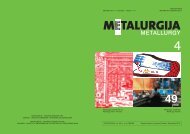Influence of Urotropin on the Precipitation of Iron Oxides from FeCl3 ...
Influence of Urotropin on the Precipitation of Iron Oxides from FeCl3 ...
Influence of Urotropin on the Precipitation of Iron Oxides from FeCl3 ...
Create successful ePaper yourself
Turn your PDF publications into a flip-book with our unique Google optimized e-Paper software.
1024 A. ŠARI] ET AL.<br />
The FT-IR spectra were recorded using a Perkin-Elmer spectrometer 2000 model.<br />
The IRDM (Infrared Data Manager) program, obtained by Perkin-Elmer, was<br />
used to process <strong>the</strong> recorded spectra.<br />
Mössbauer spectra were recorded using standard equipment and a 57Co source.<br />
Ma<strong>the</strong>matical dec<strong>on</strong>voluti<strong>on</strong>s <str<strong>on</strong>g>of</str<strong>on</strong>g> <strong>the</strong> recorded spectra were performed using a standard<br />
procedure.<br />
X-ray powder diffracti<strong>on</strong> measurements were performed using <strong>the</strong> Philips diffractometer<br />
MPD 1880 model (Cu-K radiati<strong>on</strong>, graphite m<strong>on</strong>ochromator and proporti<strong>on</strong>al<br />
counter).<br />
The size and shape <str<strong>on</strong>g>of</str<strong>on</strong>g> <strong>the</strong> particles were m<strong>on</strong>itored by transmissi<strong>on</strong> electr<strong>on</strong> microscopy<br />
(Opt<strong>on</strong> EM-10 model). Before <strong>the</strong> transmissi<strong>on</strong> electr<strong>on</strong> microscopic observati<strong>on</strong>,<br />
<strong>the</strong> powders were dispersed in doubly distilled water by ultras<strong>on</strong>ic waves<br />
and <strong>the</strong>n a drop <str<strong>on</strong>g>of</str<strong>on</strong>g> <strong>the</strong> dispersi<strong>on</strong> was placed <strong>on</strong> a copper grid, previously covered by<br />
a polymer film.<br />
RESULTS AND DISCUSSION<br />
FT-IR Spectroscopy<br />
The present work shows high potentials <str<strong>on</strong>g>of</str<strong>on</strong>g> FT-IR spectroscopy in m<strong>on</strong>itoring<br />
phase changes in <strong>the</strong> ir<strong>on</strong> oxide precipitates. This is illustrated by<br />
<strong>the</strong> FT-IR spectra shown in Figures 1 to 6.<br />
Figures 1 and 2 show <strong>the</strong> FT-IR spectra <str<strong>on</strong>g>of</str<strong>on</strong>g> samples C1 to C10, prepared<br />
by varying <strong>the</strong> c<strong>on</strong>centrati<strong>on</strong> <str<strong>on</strong>g>of</str<strong>on</strong>g> <strong>FeCl3</strong> , and at an initial c<strong>on</strong>centrati<strong>on</strong> <str<strong>on</strong>g>of</str<strong>on</strong>g><br />
0.025 M urotropin. After 24 hours <str<strong>on</strong>g>of</str<strong>on</strong>g> aging <strong>the</strong> precipitati<strong>on</strong> system, prepared<br />
<strong>from</strong> 0.005 M <strong>FeCl3</strong> soluti<strong>on</strong>, a mixture <str<strong>on</strong>g>of</str<strong>on</strong>g> -Fe2O3 and -FeOOH was<br />
observed. The IR bands at 563 and 464 cm –1 are due to <strong>the</strong> presence <str<strong>on</strong>g>of</str<strong>on</strong>g><br />
-Fe2O3 , whereas <strong>the</strong> bands at 896 and 799 cm –1 are typical <str<strong>on</strong>g>of</str<strong>on</strong>g> -FeOOH. At<br />
a c<strong>on</strong>centrati<strong>on</strong> <str<strong>on</strong>g>of</str<strong>on</strong>g> 0.02 M <strong>FeCl3</strong> , <strong>the</strong> -FeOOH phase appeared in sample<br />
C3, as c<strong>on</strong>cluded <strong>on</strong> <strong>the</strong> basis <str<strong>on</strong>g>of</str<strong>on</strong>g> a new and str<strong>on</strong>g IR band at 694 cm –1 . The<br />
origin <str<strong>on</strong>g>of</str<strong>on</strong>g> IR bands corresp<strong>on</strong>ding to -FeOOH, -FeOOH and -Fe2O3 will<br />
not be discussed here because adequate assignati<strong>on</strong>s <str<strong>on</strong>g>of</str<strong>on</strong>g> <strong>the</strong>se IR bands were<br />
presented in earlier papers. 18,21–23 At c<strong>on</strong>centrati<strong>on</strong>s <str<strong>on</strong>g>of</str<strong>on</strong>g> 0.05 and 0.3 M <strong>FeCl3</strong> ,<br />
<strong>the</strong> presence <str<strong>on</strong>g>of</str<strong>on</strong>g> -FeOOH, as a single phase in samples C4 and C5, is observed.<br />
These phase changes in <strong>the</strong> precipitates were associated with <strong>the</strong><br />
pH change in <strong>the</strong> mo<strong>the</strong>r liquor <strong>from</strong> 7.61 to 0.78. After 7 days <str<strong>on</strong>g>of</str<strong>on</strong>g> aging <strong>the</strong><br />
precipitati<strong>on</strong> systems C6 to C10, <strong>the</strong> main change was observed in <strong>the</strong> FT-<br />
IR spectrum <str<strong>on</strong>g>of</str<strong>on</strong>g> sample C8, precipitated <strong>from</strong> 0.02 M <strong>FeCl3</strong> . The fracti<strong>on</strong> <str<strong>on</strong>g>of</str<strong>on</strong>g><br />
<strong>the</strong> -FeOOH phase (IR bands at 896 and 800 cm –1 ) significantly increased,<br />
whereas <strong>the</strong> -FeOOH phase was absent. The pH <str<strong>on</strong>g>of</str<strong>on</strong>g> <strong>the</strong> mo<strong>the</strong>r liquor decreased<br />
<strong>from</strong> 5.55 to 5.29. This shows that <strong>the</strong> fracti<strong>on</strong> <str<strong>on</strong>g>of</str<strong>on</strong>g> -FeOOH, formed<br />
at <strong>the</strong> beginning <str<strong>on</strong>g>of</str<strong>on</strong>g> <strong>the</strong> precipitati<strong>on</strong> process, dissolved after 7 days.
















